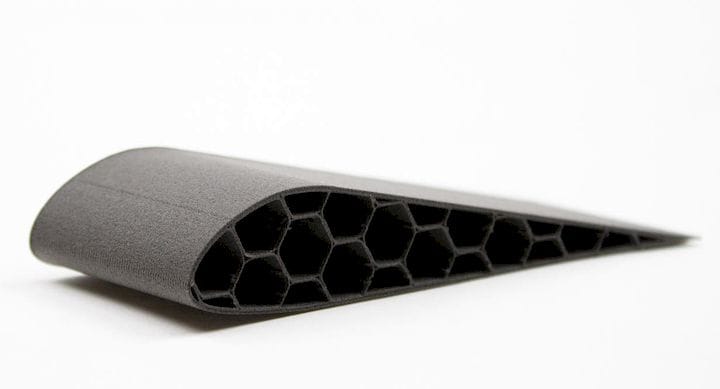![Image of a part 3D printed in a new foaming material [Source: colorFabb]](https://fabbaloo.com/wp-content/uploads/2020/05/image-asset_img_5eb09ad944a53.jpg)
colorFabb is teasing a rather strange and new 3D print material.
It seems to be able to foam during printing. Wait, how could that work? They explain in a brief LinkedIn post:
“A new development coming up! In April we will release a brand new #3Dprinting filament at #colorFabb: a light weight PLA material with active foaming technology to reduce density of the material.”
This is quite interesting in several ways.
First, one of the key advantages of 3D printing is the ability to create strong parts with light weight. Usually this is accomplished through complex 3D CAD design, in which a sparse structure is created that is composed of only the most necessary elements. These science fiction-style objects have been one of the most publicly seen examples of the technology.
In a way those complex structures are a kind of foam, where there is more air than material. Could this new material automatically provide the same benefits?
It seems that colorFabb has devised a material with “active foaming technology” that may reduce object weight. More than likely, an additive in the material will boil as it is heated, introducing bubbles into the print. These bubbles would represent the weight that is lost during printing.
Whatever their process is, it would have to take place while the material is hot and malleable.
This is puzzling, however, because eliminating bubbles from a print has been one of the main objectives of successful 3D printing. Some materials, most notably nylon, are hygroscopic and absorb moisture from the air naturally. These moisture-infused materials, when printed, tend to have very poor service quality because of the bubbles. In addition they tend to be less strong because there is less material bonding between layers.
How has colorFabb overcome these challenges? What magic are they using to insert bubbles, yet maintain proper service quality? Could it be that the bubbles are very small? Or perhaps the material has other additives that somehow constrain the bubbles from protruding?
colorFabb also says that their active foaming technology provides “up to 65% weight reduction”. If this is true, then there are a significant amount of bubbles in the extrusion. Perhaps these bubbles are very small, but also very numerous? We just don’t know yet.
One thing I can tell you though, is that the image these supplied at top is slightly misleading. It seems to be a section of an airfoil, which obviously, you would want to make as light a weight as possible. The image shows vast hexagonal empty spaces in the airfoil’s interior. Those definitely would not be produced by the new material, and they would have to have been designed in a 3D CAD system.
That’s all we know about this mystery material at this point. We don’t know when it will be released, nor its expected price. We don’t even know the name of the material!
But we will certainly be watching for further developments from colorFabb.
Via LinkedIn











An inventive designer has developed a method for producing 3D paper objects using recycled paper and 3D printed molds.